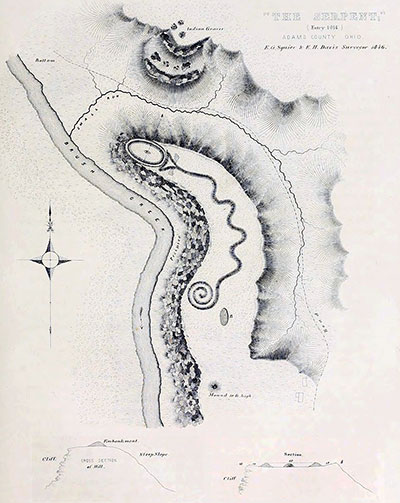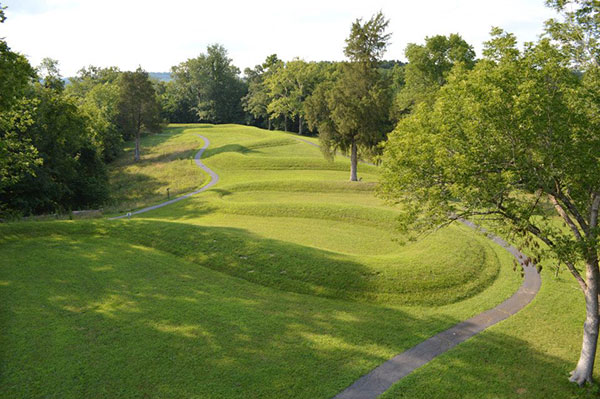The Serpent Mound State Memorial, Ohio

Site: The Serpent Mound State Memorial, Ohio
Location: 3850 OH-73, Peebles, OH 45660
Google Maps Link
Date of visit: July 2024
The Serpent Effigy Mound is one of the most famous earthworks in the United States. It was the fourth stop on our mini-mound tour. All the sites we visited have distinctive geography, but the Serpent Mound might have been the most unique. It sits on the southwest rim of a Hypervelocity Impact Crater known as Serpent Mound Crater or Serpent Mound Disturbance. A meteorite hit this part of Ohio approximately 320 million years ago, forming a complex crater 9 miles in diameter. The eroded rim gives the site its unique character. The mound sits high on a narrow strip of land with a steep drop to Brush Creek on one side and a slightly more gentle slope to Small Run on the other. This makes for an impressive sunset view when the sun aligns with the serpent head on the summer solstice.

Early Explorers
Squier and Davis' Ancient Monuments of the Mississippi Valley (1848) was the first published account of the location. Before visiting, the description of the earthwork was vague, leading them to think it might be a hill fort with bastions. The true nature of the effigy mound became apparent at their first examination.
"Conforming to the curve of the hill, and occupying its very summit, is the serpent, its head resting near the point, and its body winding back for seven hundred feet, in graceful undulations, terminating in a triple coil at the tail."
In 1883, Dr. Frederic Ward Putnam, Harvard's Peabody Museum curator, visited the site. He concluded, "Its destruction was inevitable unless immediate measures were taken for its preservation." They found no burials at the Serpent Mound but some nearby, along with signs of villages. Professor Putnam and his team excavated sections of the mound. They discovered that the hill was leveled before the construction, and the shape had been outlined with a mixture of clay and ash. The steeper portions had a base of stones to prevent erosion by heavy rains. They concluded the earthwork had been carefully planned and built. There is some discussion over who built the mound. Was it the earlier Adena culture or the later Fort Ancient culture? Was the earthwork built early on and then repaired later by other cultures? Through Putnam's efforts, in 1887, Harvard's Peabody Museum purchased 60 acres containing the Serpent Mound. In 1900, ownership of the land was given to the state of Ohio, now the Ohio History Connection. Many pages have been written about the symbology and cosmology of the serpent or snake, comparing it to cultures worldwide. Harvard University's Weatherhead Center for International Affairs has a web-based story map about the institution's relationship to the Serpent Mound.
Links to more information
- The Serpent Mound Impact Structure Ohio Department of Natural Resources
- Serpent Mound by History.com Editors, www.History.com
- The Serpent Mound of the Ohio Valley Harvard's Evolving Relationship to an Ancient Earthwork
https://storymaps.arcgis.com
References
- Randall, E. O. (1905) The Serpent Mound, Adams County, Ohio: Mystery of the Mound and History of the Serpent
ebook Hoopla www.HooplaDigital.com - Squier, E.G and Davis, E.H. (1988) Ancient Monuments of the Mississippi Valley
(Paperback Edition: 978-1-56098-725-3) Smithsonian Books; 150th anniversary ed edition (October 17, 1998)
Available as a PDF at the U.S. Library of Congress Website